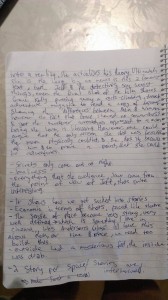Brydan Meredith, Project Brief 3 Exegesis
The Western is at its most significant when subverting conventions traditionally inscribed within the genre. The 1992 film Unforgiven is a quintessential example of a film unwilling to abide by genre conventions as it critiques and re-interprets myths embedded in the old West. Director and star of the film Clint Eastwood, a man who has built a career off Western Mythology and has since become a part of Western Iconography, told the Los Angeles Times that Unforgiven “summaries everything that he feels about the Western”. This quote frames the films meta-narrative that continually comments on the genre.
So what does a man so synonymous with the genre have to say about it? Firstly, there is an apology. Sally, the silent American Indian character in Unforgiven gives Clint Eastwood’s Will, as his character later puts it ‘the evil eye’. Sally is only in the film for 2 minutes and during her screen time she sporadically glances at Eastwood’s character with a look of hatred. Will symbolises protagonists in quintessential, traditional Westerns- where American Indians were treated as cruel and immoral animals. In Unforgiven Will is a fading Western hero who doesnt shoots gun and can’t mount a horse, he is no longer young and his days of race fuelled violence (just like the genre) are over. However, Will seems to have forgotten those days, he (like the genre) has the ability to put it behind him, whereas Sally and the rest of the Native Americans haven’t. Sally looks at him with disgust because the past has stayed with her and Will, as a symbol of the Western genre, is Unforgiven.
Eastwood continues to demythologise the Western through his depiction of violence. The violence in Unforgiven isn’t glorified. The most brutal depiction of violence is of Quick Mike slashing a prostitute in the face with his knife. This scene is horrific, the viewer hears her screams and sees the knife cut her face. This is Eastwood commenting on the reality of violence. Many of his past films (as well as other traditional Western Films) romanticise it, when a ‘bad guy’ gets shot a bucketful of red paint squirts from him in an entertaining yet unrealistic fashion. In traditional Westerns people die in a way that allow the viewer to become numb to the significance of death. Eastwood problematises this in Unforgiven as he attempts to show the disparity between reality and mythology. The reality of the West is that it is a physically cruel and barren land where people die in futile, unforgiving circumstances. This is unlike the myths that spawn from the Western frontier in the form of film and literature which suggest that death is glamorous and killing in the name of good is honourable and justified. This false mythology has created a framework used to rationalise violence in Western Film, which Eastwood (by depicting violence rooted in realism) wants to inverse. This shift away from genre norms, by questioning the morals of its basis, gives significance to Unforgiven and stops it from becoming a simple genre film. This is what I’m trying to do in my own piece of Media, I created a scene from a traditional Western where the significance of death isn’t trivialised and its permanence and gravity is understood. This is why my protagonist writes a sign that says ‘Forever’ on it in order to mark the place of his death. I am emphasising to my viewers that death in Westerns should be grounded in realism in order to evoke pathos- I am taking issue with the fact they are often depicted as trivial, insignificant often humorous events that simply speed up the narrative and entertain the viewer.
The convention of good conquering bad through violence is a genre trope that the viewer expects in every Western and unsurprisingly Unforgiven abides by it. However the film isn’t as simple as good vs bad. There are no heroes. The film abides by the trope to the extent of the protagonist (an anti-hero) killing his nemesis in the final moments of the narrative. In traditional Western films the the viewer doesn’t understand that they’re tricked, they’re tricked into believing that the good is justified in killing the bad. Unforgiven contends that they are never justified. This what The Schofield Kid learns. At the beginning of the story (like the viewer) he is fascinated and enthralled with the ways of the west, he actively self-mythologises, he wants to turn himself into a legend ‘I’ve killed five men’. Later in the film he kills his first man, a women beating criminal, and the significance of the death he dealt makes him weep. This is The Schofield Kids redeeming moment, he is ignorant and insensitive at the beginning of the film and changed when he begins to ponder the significance and permenance of death. Instead of coming of age as a superstar cowboy gunslinger (something the traditional western would promote) he instead matures in a more real sense. He has the realisation that guns and violence aren’t really all they’re cracked up to be. This is Eastwood contending that the mythology embedded in the Western is best left a myth, it should never be celebrated or brought into reality. The Schofield Kid is a surrogate for the audience, he comes into the film celebrating death and violence- he is desensitised by his own idea of the West. However by the end he understands (like the audience) the cruel and merciless reality of the West. Unforgiven is ultimately a cautionary tale warning its viewers that the Western itself is innately flawed.






